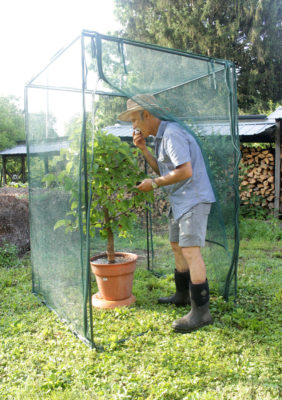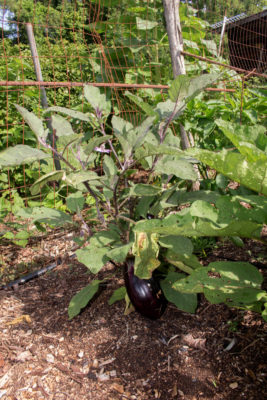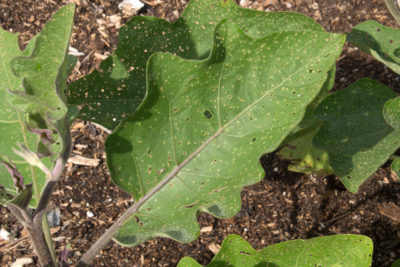GOOD FRUITS, ONE A VEGETABLE
World’s Best Fruit?
Finally, I reap the fruits of one of my labors. Literally. The fruit is black mulberry, the species, that is Morus nigra, rather than any of the black-colored mulberries that grow all over the place around here. The latter are species and natural hybrids of white and red mulberries (M. alba and M. rubra).
Black mulberry, native to the Mediterranean climate of western Asia, is not cold-hardy below temperatures in the ‘teens (Fahrenheit) so definitely not cold-hardy here. I first tasted it at a fruit conference in Davis, California and it wowed me even from among bowls heaped high with fresh-picked apricots, peaches, and other seasonal fruits.
I had to get a tree to grow, which I did (from www.whitmanfarms.com). The tree went into a pot with potting soil. As it grew, I moved it on into larger and larger pots, stopping at an 18-inch diameter pot. I figured that would be the largest pot I could muscle down the basement steps for cool, winter storage along with my figs and pomegranates.
The tree bore quickly, and the “east coast” black mulberries were delicious, what few of them I harvested. Problem was that birds also found them delicious, a problem compounded by the fact that the berries are not at their best until matte black and ready to be released from the plant at the slightest touch. The birds don’t wait that long.
Dead ripe, the fruits are so soft that they can’t help but stain your fingers. (The stain was once used as a dye, called “murry.”)
A Cagey Solution
My first solution to the bird issue was to plant the mulberry in the ground in my cool (as in temperature cool) greenhouse, which is also home to some in-ground fig trees. Since mulberry seedlings pop up all over the place around here, I just dug up a seedling, grafted onto it a stem from my black mulberry, and planted it in the greenhouse.
Mulberry trees can grow big, bigger than my greenhouse. My plan was to espalier the branches against the west wall of the greenhouse. The espalier worked as far as training the branches in an ornamental candelabra. The birds were kept at bay. The espalier did not work as far as bearing fruit, the reason for which I have no idea why. I dug up the tree.
My original mulberry still grows in a pot and, despite its small stature, still bears good crops of fruit. A few weeks ago I saw advertised a walk-in, temporary cage for protecting plants from birds (available from Gardeners Supply Co.).
The cage arrived just as the first black mulberries were ripening. Within 20 minutes I had the various pole pieces joined to each other and to the corner brackets, and the net attached over the top and sides. At 4 feet by 4 feet and 6 feet high, the cage easily accommodates my mulberry. Even another plant or two.
Every couple of days, now, I unzip the door, enter mulberry paradise, and carefully peruse the plant for dead-ripe berries. I exit with purple-stained fingers. Success.
Eggplant + Oil, A Good Combo
Another success this year has been eggplant. I’ve gardened for many, many years, and for many, many years wasn’t able to grow eggplants well. Beginning gardeners are the ones who usually have greatest success with eggplant. Not exactly beginning gardeners, but beginning gardens.

Flea beetles love to eat eggplant (leaves). They pock the leaves with enough small holes so that only vigorously growing plants survive. But flea beetles rarely show up in a garden in its first year but by the second year they descend in hoards. Hence the successes of beginning gardeners in their beginning gardens.
This year I tried controlling the beetles by spraying the plants weekly with “horticultural oil,” also called “summer oil,” which is a more refined and lighter version of “dormant oil.” I was mixing it up anyway to keep scale insects at bay on the greenhouse figs (more on that some other time). Long story short: The plants are only slight hole-y and I have a fine crop of eggplants on the way.


Why not use a row cover on the egg plant until it gets to a size that would be as affected by the flea beetles? Then remove row cover when flowers and switch to the oils. Does that new BT spray for adult beetles from Garden’s Alive called Beetle Juice work for flea beetles?
Not be affected as much as small plants* (outgrow method)
Using row covers earlier in the season is a common and effective solution to flea beetles. Not sure if the new Beetle Juice would be effective. Flea beetles are not listed on the label.
Here’s another way to deal with flea beetles. Years ago I had a massive outbreak of flea beetles in my early spring garden. I noticed that I could feel them hitting my hand when they jumped if I held my hand over the bare soil. I took a big sheet of white Styrofoam, coated it with Tanglefoot, and suspended it over the soil, propping it up with sticks. Within a short time the Styrofoam was black with captured flea beetles. I set up my traps in several areas, putting out fresh coated Styrofoam (or cardboard) sheets as the first ones became filled with bugs, flipping them to use both sides. It was gratifying, but a little grotesque, to see millions being caught. Eventually the outbreak subsided, and I never had an issue like that again. My eggplant leaves that year were pristine.
Is it foolhardy to try a Pakistan mulberry (morus macroura) in Zone 6a?
What if I potted and grew out to a diameter of 3″ inches and then put in the ground?
Just leave it in the container and enjoy what I get?
Mulberry hardiness is hard to pin down. The ideal would be to have two plants. Then you’d have one to plant out in the ground and a backup in case it got killed by winter cold. My plan is to graft stems of my Pakistani and black mulberries onto some of the mulberry seedlings, which are cold hardy, that pop up al over the place around here.